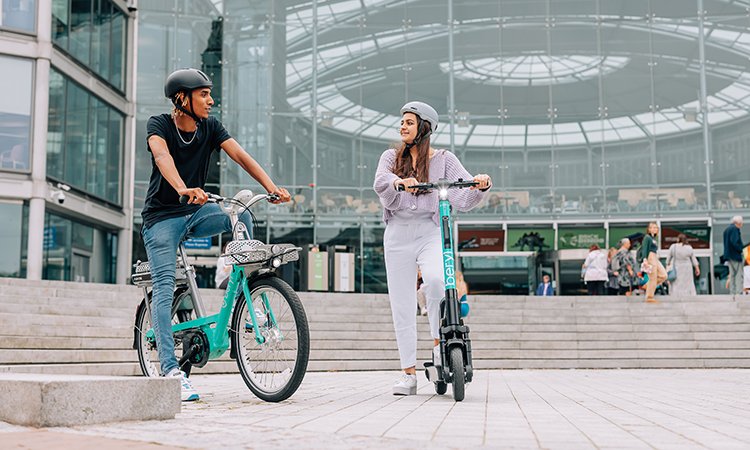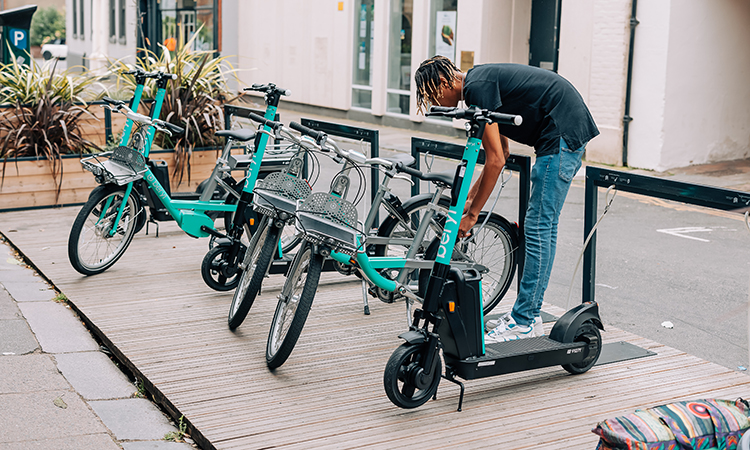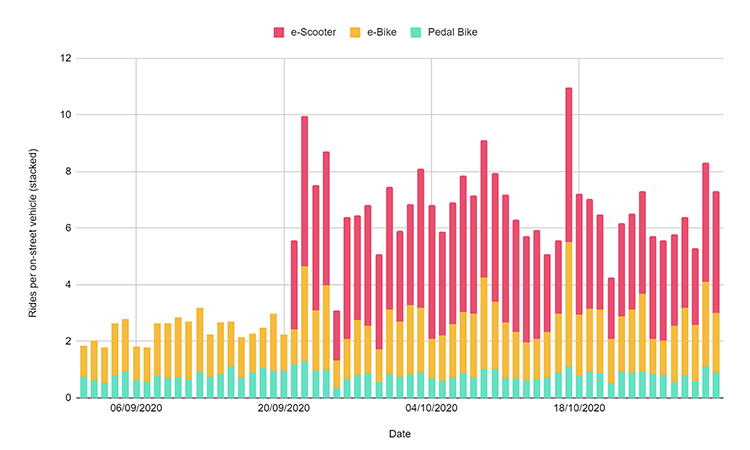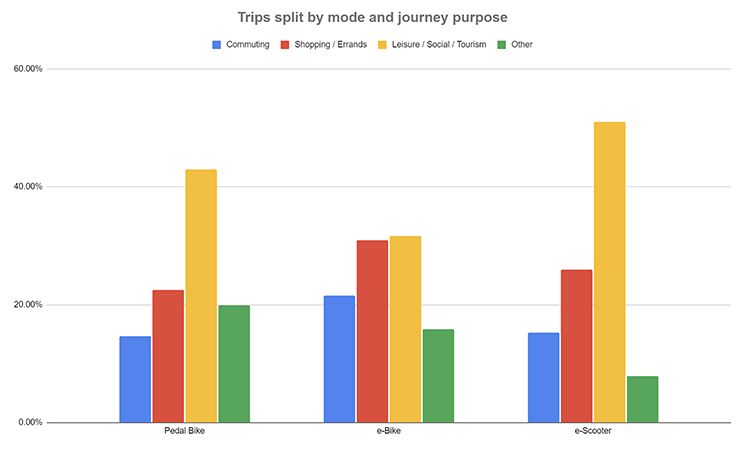Micro-mobility: The unexpected player in delivering modal shift?
- Like
- Digg
- Del
- Tumblr
- VKontakte
- Buffer
- Love This
- Odnoklassniki
- Meneame
- Blogger
- Amazon
- Yahoo Mail
- Gmail
- AOL
- Newsvine
- HackerNews
- Evernote
- MySpace
- Mail.ru
- Viadeo
- Line
- Comments
- Yummly
- SMS
- Viber
- Telegram
- Subscribe
- Skype
- Facebook Messenger
- Kakao
- LiveJournal
- Yammer
- Edgar
- Fintel
- Mix
- Instapaper
- Copy Link
Posted: 10 February 2022 | Philip Ellis - Beryl | No comments yet
For Intelligent Transport, Philip Ellis, Co-Founder and Chief Executive Officer of the UK micro-mobility company Beryl, explains how integrated micro-mobility has the potential to help solve many of the transport related problems that cities worldwide are facing at the moment and can potentially encourage significant modal shifts away from private motorised vehicles.


Credit: Beryl
The world is changing, and events such as the 2021 United Nations (UN) Climate Change Conference (COP26) have put sustainability and carbon reduction at the top of public consciousness; meaning that there has never been a better time to change the way that we travel in our towns and cities.
Across the UK, it’s exciting to see authorities starting to place micro-mobility at the heart of their transport revolutions”
We’re seeing more investment in cycling infrastructure nationally, which has led to the development of some truly excellent schemes designed to encourage people out of their cars and onto two wheels. Across the UK, it’s exciting to see authorities taking these principals on board and starting to place micro-mobility at the heart of their transport revolutions.
But micro-mobility has so much potential, and schemes must go beyond merely providing another way for people to get from A to B to fulfil it. To do this, we must think big, consider the wider impact of what we are providing and ensure that we factor in elements such as social value, enabling behaviour change, cost to benefit ratio and alignment to net zero targets.
For instance, we know that our shared schemes create new cyclists and re-introduce lapsed cyclists; so, the potential for micro-mobility and new infrastructure to be mutually beneficial, in terms of utilisation and providing value for money, is an exciting one for major cities to consider.
Defining an evolving sector
In the context of an integrated urban transport network, micro-mobility can perform a key role, solving the first- and last-mile problem by improving access to different high-speed transport modes”
But what exactly is micro-mobility? It’s hard to define, as the sector is constantly evolving, but essentially it relates to single person transport, including human-powered and electrically assisted vehicles – such as, but not limited to, bicycles, e-bikes, cargo bikes and e-scooters – which are used for short distances. In the context of an integrated urban transport network, micro-mobility can perform a key role, solving the first- and last-mile problem by improving access to different high-speed transport modes (tram, train, etc.).
The combination of the accessibility of micro-mobility modes and the spatial reach of high-speed modes creates comfortable and direct access to employment, retail, educational and leisure opportunities. This is important, especially in the current climate, as it contributes towards encouraging more people out of the private car, boosting public health and reducing congestion and harmful carbon emissions.
This may suggest that providing one mode will suffice. But our experience of working closely with local authorities to provide micro-mobility solutions has shown us that delivering a range of services can better contribute towards the aims of an integrated transport network.


Credit: Beryl
It’s not a ‘one size fits all’ solution
Each type of transport has its own benefits and appeals, meaning that, when they are delivered as a package, they can complement each other and broaden the appeal of active travel solutions.
Each type of transport has its own benefits and appeals, meaning that, when they are delivered as a package, they can complement each other and broaden the appeal of active travel solutions”
Bikes are a fun, easily accessible and highly cost-effective way for people to get around and make short journeys – making them appealing to low-income households, in particular. E-bikes, with their extra power, can be used for longer and more physically challenging journeys, while e-scooters can provide a more accessible option for people with some physical disabilities. Cargo bikes, which have ample storage facilities, can be used for transportation and deliveries and are a sustainable alternative to the white van.
One user of Beryl’s Cargo Bike Share scheme in Hackney uses the vehicles to transport his tools between sites where he works as a carpenter, specialising in conserving historic buildings. Not only does he claim that this has resulted in significant savings on petrol costs, but he also estimates that it takes him 50 per cent less time to get to sites than it did in his van.
Following the data
As well as anecdotal evidence, the benefits of multimodality are underpinned by statistics and user data drawn from our schemes. This can be seen in a direct comparison between our schemes in Bournemouth, Christchurch and Poole (BCP) and Norwich, which have two modes and three modes, respectively. BCP currently has 900 bikes and 250 e-scooters, while Norwich has 400 bikes, 100 e-bikes and 250 e-scooters.
The introduction of e-scooters in Bournemouth and Poole in January 2021, to supplement the bikes, has led to a rapid increase in trips, users and the overall success of the scheme. These trips have led to a real reduction in vehicular use, with feedback from users showing that well over a quarter (33 per cent) of e-scooter journeys in the BCP Council region have replaced road transport journeys – including driving a car/van, being a passenger in a car/van, using a taxi or riding a motorbike or moped. With over 100,000 e-scooter trips, this represents a removal of 34,000 vehicular trips from the BCP road network.
However, by examining data from the three-mode Norwich scheme, we can see that, rather than providing a surplus of options, the implementation of e-bikes could develop the BCP scheme even further. Data shows that, when e-scooters were added to the existing bike and e-bike scheme in Norwich in September 2020, the usage of the existing two modes remained unaffected (see table below). This suggests that each vehicle type plays a singularly important role in the micro-mobility system in Norwich.


Figure 1 – Graph displaying rides per on-street vehicle, split by type of Beryl vehicle.
Reinforcing this point, a comparison of our three schemes with e-bikes – Hereford, Norwich and Watford – shows that the average number of rides per e-bike is 2.4 per day, whether e-scooters are present or not (Norwich being the only scheme with e-scooters). This further underpins the notion that each mode plays a specific role in a scheme and that the introduction of additional modes does not negatively impact the demand of another.


Figure 2 – Graph displaying average rides per Beryl e-bike in Hereford, Norwich and Watford.
Feedback from our users also points towards the same conclusion. Our annual Demographic Survey, which we ran in August 2021, generated over 1,000 responses from our users. It was designed to gain insight into who our users are, what they care about and their behaviour before, during and after riding a Beryl vehicle. One of the findings that we took from the responses was that, while pedal bikes and e-scooters are more popular (than e-bikes) for leisure riding, e-bikes are preferable for commuting, shopping or running errands. This data arguably provides further evidence that e-bikes have a complementary journey profile to pedal bikes and e-scooters.


Figure 3 – Graph displaying the trips made by Beryl vehicles split by mode and journey purpose.
The survey also showed us that those with access to and using multiple vehicle types are more likely to be cycling more often than they were before trying micro-mobility. Of those that had access to and used all three modes available to them, 63 per cent said that they had been cycling either much more often or more often than they were before. This is noticeably more than those who just had access to and used a single mode; with 51 per cent of people only using e-bikes and 47 per cent of people only using bikes, claiming that they had been cycling either much more often or more often than they were before trying them.
Further examination of our respondents’ riding behaviour shows that multimodal users take more journeys and ride further. In schemes where people had used all three modes available, the average total number of journeys was 34.8 per person, while the average journey distance was 3.26km. Compare this to areas where just bikes were ridden, where the average total number of journeys was 8.4 and average distance was 1.04km; or areas where just scooters were ridden, where the average total number of journeys was 8.1 and average distance was just under 1km.
Having access to more vehicle options also appears to make our users more open to trying others. When asked if they were interested in using cargo bikes, 58 per cent of respondents in Norwich (three modes) said that they were open to using them, compared to just 45 per cent of respondents in the Isle of Wight (one mode).
People using three modes are also more likely to have reduced their usage of cars. Again, looking at respondents who used three forms of micro-mobility, we can see that five per cent of respondents said that they had completely stopped using their car, and 30 per cent said that they had used their car less often since using Beryl vehicles. Compare this to areas where users just rode bikes, where no respondents said that they had completely stopped using the car and 25 per cent said that they had used it less often.
Looking to the future
Ultimately, although travel behaviour has been affected by the COVID-19 pandemic, we’ve seen shared micro-mobility develop rapidly over the last few years”
Ultimately, although travel behaviour has been affected by the COVID-19 pandemic, we’ve seen shared micro-mobility develop rapidly over the last few years, and it now represents a genuine transport option for millions of people. Its function as a sustainable and emission-free method of transport has seen it thrive in an increasingly environmentally conscious society; while its relatively low-cost, in comparison with soaring fuel prices, makes it financially appealing.
The next step is looking at how we develop shared micro-mobility to ensure that it moves beyond its existing guise as a sustainable transport option and evolves to become a strategic pillar of any urban transport regeneration scheme. We’ve shown that, by following the data and listening to our users, we understand that better infrastructure and quieter roads are important in encouraging people to adopt active travel measures.
Providing this infrastructure in the form of more comprehensive and multimodal schemes can appeal to a wider range of people and encourage more people to adapt to sustainable transport. And the importance of that cannot be overstated.
Philip Ellis is the Co-Founder and Chief Executive Officer of the UK micro-mobility company Beryl.
Ellis has built up a significant depth of industry knowledge, leading the development and delivery of technology and safety projects for the global bike sharing and micro-mobility industry since 2014; including the delivery of innovations to Transport for London (TfL) and West Midlands Cycle Hire, as well as mobilising Greater Manchester’s Bee Network cycle hire scheme.
Under his leadership, the Beryl bikeshare business launched with a commitment to delivering shared bike/e-bike and micro-mobility systems in partnership with local authorities, at a time when much of the industry was focused on rapid deployments and limited control.
Related topics
Alternative Power, COVID-19, Mobility Services, Multimodality, On-Demand Transport, Passenger Experience, Sustainable Urban Transport, Traffic Management
Related modes
Bikes & Scooters
Related cities
Bournemouth, Christchurch, Hereford, Isle of Wight, Norwich, Poole, Watford
Related countries
United Kingdom
Related organisations
Beryl, Bournemouth Christchurch and Poole (BCP) Council, United Nations (UN)
Related people
Philip Ellis








